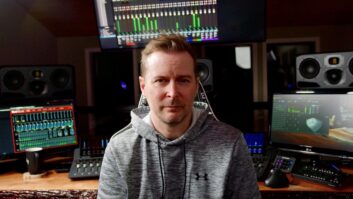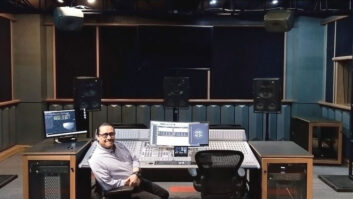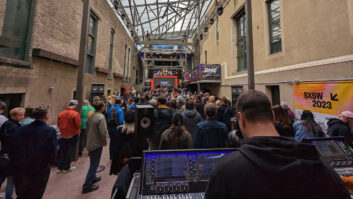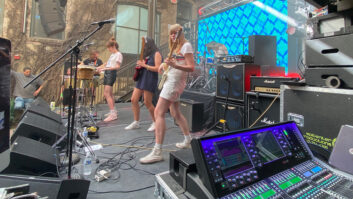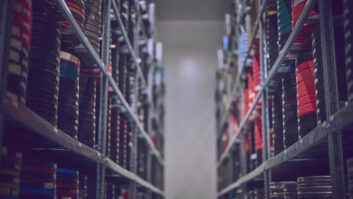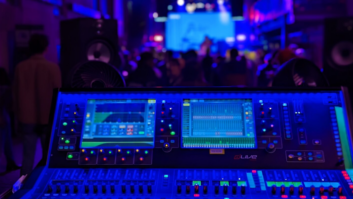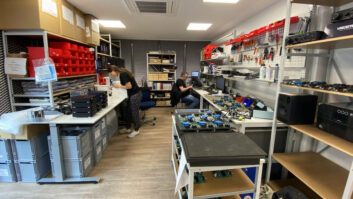Cinesonic was created by Bill Sheppard and Dean Giammarco, two guys who had a ton of work on their hands and nowhere to complete it. By a strange twist of fate, they found an old movie theater complex in West Vancouver that turned out to be a perfect match to their needs.
“We had the work but not necessarily the facility to start pulling off some of the bigger projects we were getting,” explains partner Giammarco. “We had a heck of a time finding a place to do the work we had. For the past six years or so, we had been going down to San Francisco to finish our feature mixes. Wherever we went, we would spend half a day to a day just setting things up to do our mixes. We started looking around, and when we found out this place was available, we decided to go for it.”
The Cinesonic building has a lot of history in its walls. Originally built in 1965, the Twin Cinemas packed the house regularly for three decades before it was forced out of business in the late ’90s. “I grew up watching movies here,” says founding partner Sheppard. “I can remember coming to matinees and watching Sinbad and Godzilla films on Saturday afternoons.”
Within six months of finding the space, and after some construction, installation and rewiring, Sheppard and Giammarco had Cinesonic up and running. The 30,000-square-foot facility is spacious and comfortable, and is a hip blend of retro film gear and the latest automated editing, mixing and routing technology. Amazingly, all of the machines that were left behind from the movie house were in good working order. The only thing that didn’t work was the ice machine, which, of course, Sheppard and Giammarco fixed immediately.
“The great thing was realizing as we started playing with the equipment that everything was working,” says Giammarco. “It was just little tune-ups here and there. The way the equipment started working together was very encouraging. We worked for two weeks straight on a feature dub without a single crash. There wasn’t a single bit of downtime.”
The centerpiece of the facility is the dub stage, which was modified from its pre-existing function as a movie theater into a full mixing stage. Sixty seats were removed from the center of the room and a level floor poured in the middle to accommodate the Digidesign Pro Control console and work area. Once things began to take shape, the two partners had to pinch themselves to make sure that they weren’t dreaming. “We laughed a lot of the time,” recalls Sheppard. “We sat in this room giggling, knowing we had stumbled upon something that’s incredible.”
Both partners are extremely happy with their modular Pro Control console. The newest piece they’ve installed is the Edit Pack, which has a built-in keyboard, trackball and joystick for 5.1 panning, allows the use of Pro Tools short-cuts for automation and importing audio, and features better metering and other cool features. “What’s great for us,” says Sheppard, “is that both Dean and I edit as well, so to be an editor and understand your way around Pro Tools, and to be a mixer and understand mixing is the best of both worlds. It’s the perfect crossover, because we can do absolutely anything on the editing side and everything is 100 percent automated so you can do anything mix-wise. It opens you up completely creatively, where you’re not stifled by anything.”
The modular and expandable capabilities of the board allow the pair to split up the console so that they can both work at the same time if necessary. All routing for outboard gear is run through the Z-SYS patching setup for sharing effects. Instant recall of patches allows someone to come and do a fix-up from a different show while the other mixers are out having lunch, and have everything back to normal before they return.
Working in a variety of studios and environments motivated Sheppard and Giammarco to create a highly efficient, comfortable space to complete their projects. Right from the start, they emphasized consistency as their goal, exemplified by the design of their editing suites to be exactly the same so that there is less time spent adapting to the layout of each room.
Each of the four Pro Tools editing suites is equipped with 03D mixers for instant recall of patches, making it easier for the dialog editors to get up and running quickly after others have used the room. The all-digital suites are sensibly designed, with PMC speakers and a large Sony Wega monitor inset into the walls, helping to create a minimal clutter workspace. All machines, including Bryston power amps and Mac G4 computers, are located behind the wall for a quiet working environment, and are stored in rolling racks for quick change-overs if necessary. Each room has Z-SYS routing for ease of access to the outboard gear, with instant recall patches for individual sessions and users.
A decision was made early on not to have a central computer room. “In the past,” explains Sheppard, “working in places with centralized computer rooms was really handy in some ways, but we find it easier and cheaper, cabling-wise, to send stuff over Ethernet. Now you’re able to keep things centralized through the Ethernet and patching, as opposed to having the machines side by side and doing hard patches. You’re not swapping drives anymore; you can do it over the Internet so fast. The only thing we do have centralized is all the V1 video serving.”
One of the jewels at Cinesonic is the 450-seat screening theater, which is equipped with a JBL/Crown 5000 Series THX-approved monitor system. “It’s really great, because we can come in here after we’ve done a show and play it back,” enthuses Sheppard. “We installed bi-phase motors on the old 35mm projectors so we can actually lock Pro Tools and Tascams to it, and we can play it back right off the mix. Because it’s an old room, it’s a much different style from what they’re building now, but we figure if it sounds good in here, it will sound great anywhere. It’s still running on all the old film gear, with the original Altec amps.”
One of the other antiques left behind was a platter system for 35mm screening, a superior system to the old reel method, which involved lots of change-overs, techie time and room for error.
Cinesonic’s layout is essentially the same as the original theater. Editing suites were constructed in the entrance/ticket booth area, and a large Foley room was created behind the dub stage screen. There is a large office area and additional suites equipped with Avid Media Composer 9000 for features and Final Cut Pro for television work.
The concession stand/lobby area was transformed into a recreation room for clients and staff, complete with a comfy viewing area, cappuccino bar and lots of games, including shuffleboard, air hockey and football. Producers love it so much that they often have their screening parties here once their project is wrapped.
“The bowling alley is right beside us and the driving range is right behind us,” says Sheppard. “When clients are here, there’s lots for them to do while they’re having lunch or waiting to hear a mix. The beach is a five-minute walk and the mall is right there if they need to go shopping.”
In addition to feature films, Sheppard and Giammarco are having a blast mixing and creating sounds for the hit cartoon show Ed, Edd and Eddie, which is currently in its fourth season. “It’s an excellent show to work on,” says Sheppard. “It’s fun and the producer/director, Danny Antonucci, wants something new every time, and he pushes us to our limits. He doesn’t settle for second best, and he makes us work for it. Nothing in the show is from a library.”
Although their bread and butter right now is coming from TV work, the pair ultimately would like to focus on feature mixing. They have recently completed mixing for two feature films, including Dead Heat and Liberty Stands Still, both of which were shot in Vancouver, and which would normally have been taken down south and mixed in Los Angeles. “What we’re trying to do is say, ‘If you’re here saving money on your production, why don’t you stay and save money on your mixing as well?’” says Sheppard. “In terms of Vancouver, I think there’s room for an option.”
For now, the Cinesonic partners are content to let the buzz for the studio build by word of mouth, rather than via an expensive advertising campaign. They’re also not opposed to working on short films and giving a break to emerging filmmakers, knowing that these people could be the big players of tomorrow. Like two big kids in a huge candy store, they’re just having fun.
Tim Moshansky is a freelance writer based in Vancouver. He has recently released the third edition of his book, The A to Z Guide to Film Terms.
